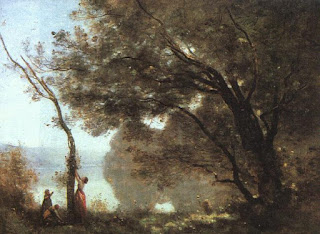 |
| Charging Chasseur, 1812, Theodore Gericault |
The word "romantic" is bound up in all kinds of images involving hearts and flowers, cupids, valentines, candy, crooning tunes, and spooning under the looming moon in June. Strictly speaking, it means "Roman-like." I'm not sure how the two ever came to be equated. So far as I know, the Romans were no more "romantic" than anyone else. However, I think probably our present day associations with the word date back to the Romantic period in the arts, and the first half of the nineteenth century, an era sometimes known as Romanticism. Like so many art eras, the Romantic period was not limited merely to painting. It had a presence in music, and actually was perhaps strongest in literature. In fact, literary Romanticism still endures, albeit in a somewhat raunchier form, on the book shelves of supermarkets today.
 |
| Death of Sardanapalus, 1828, Eugene Delacroix |
In painting, as in literature, it was all about lovely, helpless ladies, powerful, colorful heroes, heroic deeds, violence, death and dying, mourning, tears, love, hate and all that. Sounds like a typical afternoon soap opera, doesn't it? Artistically it was about Theodore Gericault, Eugene Delacroix, J.M.W. Turner, and John Constable. The first two were French, the latter two, English. The first two painted wild scenes from mythology, the Bible, and even current events, while the latter two were landscape painters. Romantic
 |
| The Hay Wain, 1821, John Constable |
landscapes? Yes, Turner was partial to sunsets...or sunrises...usually it's hard to tell and romantically speaking it makes little difference. Constable was more prone to nostalgia, glorious skies, lovely rivers and streams, hot summer days, clouds, livestock, small towns with church spires off in the distance, and everyday people leading everyday lives. It may not
sound all that romantic but in Constable's talented hands, it was quite soul stirring.
 |
The Fighting Timeraire Towed to her Final Berth to be
Broken Up, 1839, J.M.W. Turner |
In France, Romanticism was a reaction to the high-flown, stilted, moral rectitude of the Classical era during the early part of the 1800s. That, of course, had been a reaction to the Rococo flights of fancy of the century before. So the French, in fact, were wildly swinging from one extreme to the other. Gericault and Delacroix not only
painted Romanticism, they lived wildly romantic lives themselves. The English, on the other hand, had always been somewhat romantic in their artistic tastes dating back to the landscape backgrounds of Reynolds and especially Gainsborough. Turner and Constable merely dispensed with the distracting portraiture in the foregrounds and concentrated upon beautiful settings, tranquil and serene scenes as seen by Constable; the wild, woolly, wind, rain, and fire as seen by Turner. So, the next time your start feeling "romantic," remember the debt you owe to the Romantic painters. There's more to it than hearts and flowers.














































